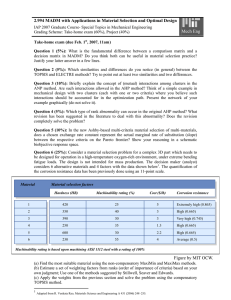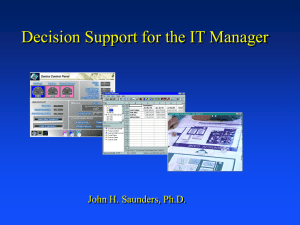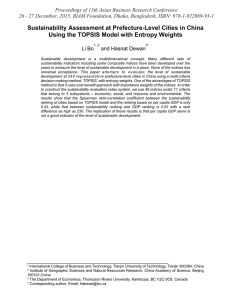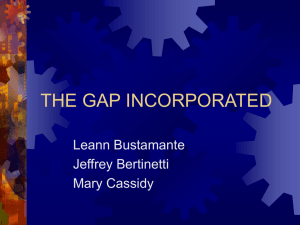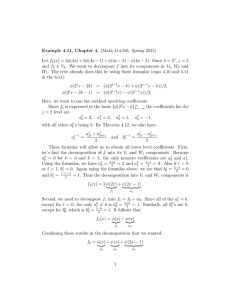www.ijecs.in International Journal Of Engineering And Computer Science ISSN:2319-7242
advertisement
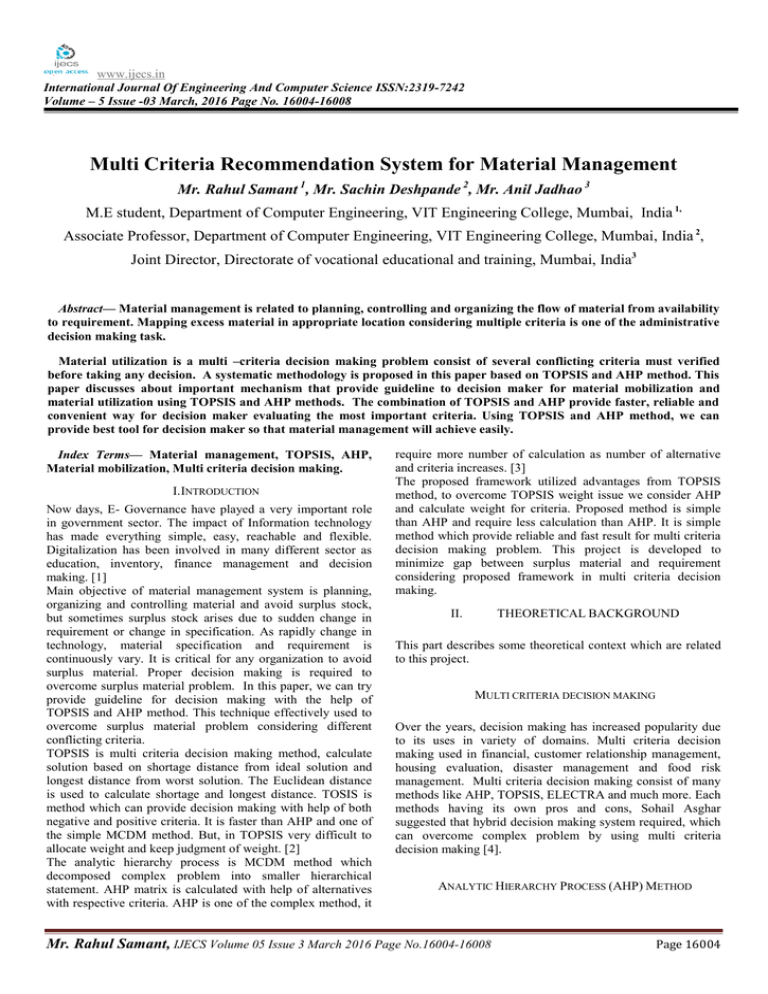
www.ijecs.in
International Journal Of Engineering And Computer Science ISSN:2319-7242
Volume – 5 Issue -03 March, 2016 Page No. 16004-16008
Multi Criteria Recommendation System for Material Management
Mr. Rahul Samant 1, Mr. Sachin Deshpande 2, Mr. Anil Jadhao 3
M.E student, Department of Computer Engineering, VIT Engineering College, Mumbai, India 1,
Associate Professor, Department of Computer Engineering, VIT Engineering College, Mumbai, India 2,
Joint Director, Directorate of vocational educational and training, Mumbai, India3
Abstract— Material management is related to planning, controlling and organizing the flow of material from availability
to requirement. Mapping excess material in appropriate location considering multiple criteria is one of the administrative
decision making task.
Material utilization is a multi –criteria decision making problem consist of several conflicting criteria must verified
before taking any decision. A systematic methodology is proposed in this paper based on TOPSIS and AHP method. This
paper discusses about important mechanism that provide guideline to decision maker for material mobilization and
material utilization using TOPSIS and AHP methods. The combination of TOPSIS and AHP provide faster, reliable and
convenient way for decision maker evaluating the most important criteria. Using TOPSIS and AHP method, we can
provide best tool for decision maker so that material management will achieve easily.
Index Terms— Material management, TOPSIS, AHP,
Material mobilization, Multi criteria decision making.
I. INTRODUCTION
Now days, E- Governance have played a very important role
in government sector. The impact of Information technology
has made everything simple, easy, reachable and flexible.
Digitalization has been involved in many different sector as
education, inventory, finance management and decision
making. [1]
Main objective of material management system is planning,
organizing and controlling material and avoid surplus stock,
but sometimes surplus stock arises due to sudden change in
requirement or change in specification. As rapidly change in
technology, material specification and requirement is
continuously vary. It is critical for any organization to avoid
surplus material. Proper decision making is required to
overcome surplus material problem. In this paper, we can try
provide guideline for decision making with the help of
TOPSIS and AHP method. This technique effectively used to
overcome surplus material problem considering different
conflicting criteria.
TOPSIS is multi criteria decision making method, calculate
solution based on shortage distance from ideal solution and
longest distance from worst solution. The Euclidean distance
is used to calculate shortage and longest distance. TOSIS is
method which can provide decision making with help of both
negative and positive criteria. It is faster than AHP and one of
the simple MCDM method. But, in TOPSIS very difficult to
allocate weight and keep judgment of weight. [2]
The analytic hierarchy process is MCDM method which
decomposed complex problem into smaller hierarchical
statement. AHP matrix is calculated with help of alternatives
with respective criteria. AHP is one of the complex method, it
require more number of calculation as number of alternative
and criteria increases. [3]
The proposed framework utilized advantages from TOPSIS
method, to overcome TOPSIS weight issue we consider AHP
and calculate weight for criteria. Proposed method is simple
than AHP and require less calculation than AHP. It is simple
method which provide reliable and fast result for multi criteria
decision making problem. This project is developed to
minimize gap between surplus material and requirement
considering proposed framework in multi criteria decision
making.
II.
THEORETICAL BACKGROUND
This part describes some theoretical context which are related
to this project.
MULTI CRITERIA DECISION MAKING
Over the years, decision making has increased popularity due
to its uses in variety of domains. Multi criteria decision
making used in financial, customer relationship management,
housing evaluation, disaster management and food risk
management. Multi criteria decision making consist of many
methods like AHP, TOPSIS, ELECTRA and much more. Each
methods having its own pros and cons, Sohail Asghar
suggested that hybrid decision making system required, which
can overcome complex problem by using multi criteria
decision making [4].
ANALYTIC HIERARCHY PROCESS (AHP) METHOD
Mr. Rahul Samant, IJECS Volume 05 Issue 3 March 2016 Page No.16004-16008
Page 16004
DOI: 10.18535/ijecs/v5i3.23
The Analytic Hierarchy Process has been developed by T.
Saaty. It allows users to assess weight of multiple criteria in an
intuitive manner [5]. Analytic Hierarchy Process allows a
logical mixture of data, which could be qualitative,
quantitative, experience, intuition and insight in its algorithmic
framework. AHP is used in many field to make decision
making, such as business, education, government, healthcare
and industry [6]. One of the advantage of AHP is that it shows,
how changes in priority of criteria at upper levels have a result
on the priority of criteria at lower levels. It also provide
stability and flexibility respecting changes within and
additions to the hierarchy [7]. However, AHP has some week
point like it’s complexity for implementation. As number of
hierarchy level increases, the number of pair comparison also
increases, so it require more time and effort to build AHP
model. Also, AHP method cannot guarantee the decisions as
absolutely true [8].
Selection [21]. Mohuya B. Kar et al. (2014) used fuzzy
TOPSIS method for suppler selection. He construct a fuzzy
based decision network for TOPSIS method considering
global risk criteria and alternatives [22].
III.
PROPOSED METHOD
This methodology for material donor selection using TOPSIS
Method consists of following Step:
Identify the criteria to be used in the model;
By using expert views weighing the criteria;
Integration of AHP to obtain preferences weight for
criteria
Evaluation of alternatives with TOPSIS and
determination of the final mark.
TOPSIS
TOPSIS consider Euclidean distance to get best alternatives,
this method select alternatives using shortest Euclidean
distance from best solution and farthest from negative solution
[9]. The decision matrix examine both subjective and objective
elements. Each criterion in the TOPSIS method is conclude to
take either monotonically decreasing or increasing utility [10].
It has simple process which takes input as any number of
criteria and attributes. It is easy to use and programmable.
Attribute defines number of steps required to developed
TOPSIS model. It has been used in business and marketing,
supply chain management, design engineering and
manufacturing system [11]. The biggest disadvantage of
system is, TOPSIS not consider uncertainty in weights. Thus
some time its produce unreliable result [9].
MATERIAL MANAGEMENT
The objective of material management is to mapping excess
material in appropriate location considering multiple criteria.
It is much more similar approach like supply chain
management system. Ghodsypour and O’Brien (1998) present
integration of linear programming and AHP to consider both
tangible and intangible factors to select the best suppliers.
They consider multiple sourcing problem, with multiple
criteria and capacity [12]. Karpak and Kasuganti (1999) have
proposed visual interactive goal Programming for supplier
selection process [13]. Liu et al. (2000) proposed data
envelopment analysis (DEA) to compare the performance
rating of different supplier for best selection [14].Chaudhry et
al. (1991) have present integer goal programming allocating
order quantities among suppliers [15]. Kumar et al. (2002)
have used fuzzy integer goal programming for supplier
selection [16]. Chan et al. (2007) used an AHP to determine
the optimal supplier. His project consider 14 criteria to choose
best suppliers [17]. Wadhwa and Ravindran (2007) used a 3
objectives, for supplier selection methodology, such as price,
rejects and lead time. All of these objective functions are
minimization [18]. Similarly, Vahdani et al. (2008) also
praduced a three step methodology considered balancing and
ranking [19]. Chiou et al. (2005) presented a fuzzy hierarchical
analytic process to determine the weights of criteria [20].
Aditya Hosanagara Kumaraswamy et al. (2011) used An
Integrated QFD and TOPSIS Methodology for Supplier
Figure 1: Flow Chart
IV.
PROBLEM STATEMENT
Decision making Systems (DSS) are computer-based systems
supporting decision making activities. DMS collect knowledge
coming from several domain such as decision theory, artificial
intelligence, database research, mathematical models and so
on. Multiple Criteria Decision Making (MCDM) is a one of
Mr. Rahul Samant, IJECS Volume 05 Issue 3 March 2016 Page No.16004-16008
Page 16005
DOI: 10.18535/ijecs/v5i3.23
the method used to find best alternatives for DMS from
multiple conflicting criteria. MCDM techniques are able to
solve complex problems characterized by different objectives.
MCDM problems are mostly used in real life applications
within several domain: for example when buying a house or a
car multiple criteria, such as size, price, consumptions, and
style need to be taken into consideration. MCDM is used can
be found in the finance, business and industrial contexts.
TOPSIS and AHP are two MCDM methods, each one have
pros and cons. TOPSIS used any number of attributes and
criteria, less comparison and easy to implement. But allocating
directly weightage to criteria is difficult and provide unreliable
result. AHP is flexible and scalable method but hard to
implement. This project implemented TOPSIS method and
instead of assigning directly weightage to criteria, combine
AHP method and then calculate weight for criteria. The main
objective of this project is to investigate a new approach based
on TOPSIS and AHP that can provide more accurate decision
making in multi criteria environment.
The aim of this project is developed a methodology for
managing surplus material to required location in Directorate
of Vocational Educational and Training. This paper has
developed for selection of material donor by using
combination of TOPSIS and AHP method. For this selection
three different criteria are taking into account and weightage
of criteria is calculate using AHP method. On this basis of
criteria weightage, we produce rank of every donor with help
of TOPSIS method.
Figure 2 indicate criteria matrix, perform AHP method on
criteria table and calculate rank with weightage for each
criteria. Figure 3 indicate ranks for each criteria.
Figure 3: Criteria with their weightage
V.IV Evaluation of alternatives with TOPSIS
In last stage, ranks are determined using TOPSIS Method.
TOPSIS method consist of six activities is listed below.
ACTIVITY- 1
Establish a decision matrix for the ranking. The structure of
the matrix can be expressed as follows:
B1 B2 …… Bn
D = A1 P11 P12....... P1n …. ……An Pm1 Pm2 …… Pmn (1)
Where Ai denotes the alternatives i, i = 1…., m;
Bj represents jth attribute or criterion, j = 1…., n, related to ith
alternative; Pij is a crisp value indicating the performance
rating of each alternative Ai with respect to each criterion Bj.
Decision matrix is based on following pointer system.
V.I Selection of alternatives
Criteria 1
For criteria 1 create matrix which indicate pointer system.
Maximum 9 and minimum 1
In first step, identify list of institute having excess martial
related to shortage. In this process we choose any institute and
then select shortage machine in respected institute. For
example Institute code 0001 require machine code 1000 then
all institute having machine code 1000 from excess list are
listed.
Figure 4: Criteria 1
V.
IMPLEMENTATION
V.II Identify the criteria to be used in the model
In the second step, with the help of going over expert we try to
recognize variables and effective criteria in excess material
selection and the criteria which will be used their revaluation
is extracted then the list of appropriate institute are find.to
perform this task choose following three criteria.
1. Scheme under institute are working.
2. Distance between two institutes.
3. Working condition of Excess material.
V.III AHP method for weighing the criteria
After identification of criteria and approved through decision
maker, create criteria table
This figure indicate weightage for criteria 1. If shortage
material from general institute and alternative are also general
institute then it get 9 point and so on.
Criteria 2
Weightage for criteria 2 is calculated based on geographical
distance. If alternative and require institute both from same
taluka then 9 points else if both institute not in same taluka but
in same district then 7 point. If not in district but within region
then 5 point and out of region then 1 point.
Criteria 3
Weightage for criteria 2 is calculated based on working
condition. If excess material in working condition than 9 if
minor fault then 7, major fault then 5 if proposed to write off
then 3 and write off then 1
Using above three criteria decision matrix is calculated.
Figure 2: Criteria table
Mr. Rahul Samant, IJECS Volume 05 Issue 3 March 2016 Page No.16004-16008
Page 16006
DOI: 10.18535/ijecs/v5i3.23
Ei- = √ Σjn =1 (Vij – Vj-) 2, i = 1…….m (5)
Figure 5: Decision matrix
ACTIVITY - 2
Once decision matrix is calculate, normalized decision matrix
Q= [Sij].
The normalized value Sij is calculated as;
Sij = -Pij / √ Σjn= 1 Pij2 i = 1 ……n; j= 1…..m (2)
ACTIVITY-6
Once m-dimensional Euclidean distance calculated, relative
closeness to the ideal solution is calculate and rank the
alternatives in descending order.
The relative closeness of the alternative Ai with respect to
maximum V+ can be expressed as:
Hi* = Ei- / Ei+ + Ei- (6)
Where the index value of Hi* lies between 0 and 1. The lowest
the index value, the better the performance of the alternatives.
ACTIVITY-3
Weighted normalized decision matrix is calculate by
multiplying normalized decision matrix obtain from activity 2
and associated weightage from 5.5.3
The weighted normalized value Vij is calculated as:
Vij = Wij.Sij , j=1……….n; i= 1 ………m; (3)
Where wj represents the weight of the jth attribute or criterion.
Figure 9: Decision Matrix and Ranking
Figure 6: Weighted normalized decision matrix
Figure 6 indicate weighted normalized decision matrix for four
alternatives obtain from activity 3
ACTIVITY- 4
After calculating weighted normalized decision matrix,
determine maximum and minimum value for each criteria.
Determine the PIS and NIS, respectively:
V+ = {v1+ ……….. vn+}
= {(Max vij I j c J), (Min vij I j € J')}
V- = {v1-……….. vn-}
= {(Min vij I j € J), (Max vij I j € J')}
Figure 7: Maximum value for each criteria.
Figure 8: Minimum value for each criteria
ACTIVITY-5
TOPSIS method is based on Euclidean distance. Separation
measure is calculate by using m-dimensional Euclidean
distance.
The separation measure Ei+ of each alternative from the
maximum value is given as:
Ei+ = √ Σjn =1 (Vij – Vj+) 2, i = 1…….m (4)
Similarly the separation measure Ei- of each alternative from
the minimum is as follows:
Thereafter, the relative closeness coefficients are determined,
and selected alternatives are ranked. Figure 5.5.4.6 indicate
rank for each institute. List of alternatives and their rank is
vary depending upon selection of shortage institute and
respected machine.
VI.
CONCLUSION & FUTURE WORK
The aim of this research paper is to create multi criteria
decision making, with help of TOIPSIS and AHP. This model
present MCDM for evaluation of material mobilization. The
main advantage of this method is simple and effective. This
method avoid uncertainty in weight and enhance perfection of
ranking.
The present model consider three criteria, in future
more no of criteria require to consider. Above model also
consider for supplier selection.
References
[1] Rajesh Aggarwal, “eGov 0.0 (A primer on eGovernance
issues)”, A freewheeling paper, 26thJanuary 2012, with annual
Republic Day Updates 2013, 2014 and 2015.
[2] Mohammad Saeed Zaeri, “Application of multi criteria
decision making technique to evaluation suppliers in supply
chain management” African Journal of Mathematics and
Computer Science Research Vol. 4 (3), pp. 100-106, March,
2011.
[3] E. Triantaphyllou, “Multi-Criteria Decision Making: An
Operations Research Approach” Encyclopedia of Electrical
and Electronics Engineering, (J.G. Webster, Ed.), John Wiley
& Sons, New York, NY, Vol. 15, pp. 175-186, (1998).
Mr. Rahul Samant, IJECS Volume 05 Issue 3 March 2016 Page No.16004-16008
Page 16007
DOI: 10.18535/ijecs/v5i3.23
[4] Sohail Asghar, “A Survey on Multi-Criteria Decision
Making Approaches” 2009 International Conference on
Emerging Technologies, IEEE.
[5] Nadja Kasperczyk and Karlheinz Knickel “The Analytic
Hierarchy Process (AHP).
[6] Fadwa Gamal Mohammed AI-Azab “Web Based Multi
Criteria Decision Making Using AHP Method” 2009
International Conference on Emerging Technologies, IEEE.
[7] Shahroodi “Application of Analytical Hierarchy Process
(AHP) Technique to Evaluate and Selecting Suppliers in an
Effective Supply Chain” Kuwait Chapter of Arabian Journal
of Business and Management Review Vol. 1, No.8; April
2012.
[8] Senay OĞUZTİMUR” Why Fuzzy Analytic Hierarchy
Process Approach For Transport Problems”
[9] Rohan K. Gavade “Multi-Criteria Decision Making: An
overview of different selection problems and methods”
(IJCSIT) International Journal of Computer Science and
Information Technologies, Vol. 5 (4), 2014, 5643-5646.
[10] C.L. Hwang and K. Yoon, Multiple Attributes Decision
Making Methods and Applications. Berlin, Heidelberg:
Springer, 1981.
[11] Mark Velasquez, An Analysis of Multi-Criteria Decision
Making Methods. International Journal of Operations Research
.
[12] S.H. Ghodsypour and C. O’Brien, “A decision support
system for supplier selection using an integrated analytic
hierarchy process and linear programming”, International
Journal of Production Economics, vol. 56–57, pp. 199–212,
Sept. 1998.
[13] O. Bayazit and B. Karpak, “An AHP application in vendor
selection”, Proc. ISAHP 2005, Honolulu, Hawaii, July 8–10,
2005, pp. 1–24.
[14] Liu J, Ding FY, Lall V (2000). Using data envelopment
analysis to compare suppliers for supplier selection and
performance improvement. Supply Chain Manag. Int. J., 5:
143-150.doi: 10.1108/13598540010338893
[15] Chaudhry SS, Forst FG, Zydiak JL (1991). Multi criteria
approach to allocating order quantities among suppliers. Prod.
Invent. Manag. J., 3: 82-5.
[16] Kumar M, Vrat P, Shankar R (2002). A multi-objective
interval programming approach for supplier selection problem
in a supply chain. Proceedings of International Conference on
Manufacturing: An Emerging Need for 21st Century World
Class Enterprises, Nov. 17-19.
[17] Chan FTS, Kumar N (2007). Global supplier development
considering risk factors using fuzzy extended AHP-based
approach. OMEGA – Int. J. Manag. Sci., 35: 417-431.
[18] Wadhwa V, Ravindran AR (2007). Vendor selection in
outsourcing. Comput. Operat. Res., 34: 3725-3737. doi:
10.1016/j.cor.2006.01.009.
[19] Vahdani B, Zandieh M, Alem-Tabriz A (2008). Supplier
selection by balancing and ranking method. J. Applied Sci., 8:
3467-3472...
[20] Chiou HK, Tzeng GH, Cheng DC (2005). Evaluating
sustainable fishing development strategies.
[21] Aditya Hosanagara Kumaraswamy, an Integrated QFDTOPSIS Methodology for Supplier Selection in SMEs, 2011
Third International Conference on Computational Intelligence,
Modelling & Simulation, IEEE DOI10.1109/CIMSim.2011.55.
[22] Mohuya B. Kar, A Network-TOPSIS based fuzzy decision
support system for supplier selection in risky supply chain,
2014 Seventh International Joint Conference on Computational
Sciences and Optimization. IEEE DOI 10.1109/CSO.2014.61
[23] William Ho, Xiaowei Xu, Prasnata K. Dey. Multi Criteria
decision making approaches for supplier evaluation and
selection, European Journal of Operational Research (2010),
Volume: 202, Issue: 1, Publisher: Elsevier, Pages: 16-24.
[24]K .Chatterjee and S. Kar, “A Hybrid MCDM approach for
selection of Financial Institution in Supply Chain Risk
Management, IEEE International Conference on Fuzzy System,
FUZZ IEEE Hyderabad
Mr. Rahul Samant, IJECS Volume 05 Issue 3 March 2016 Page No.16004-16008
Page 16008
